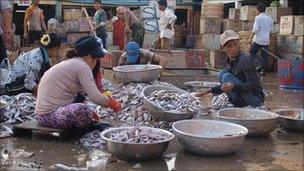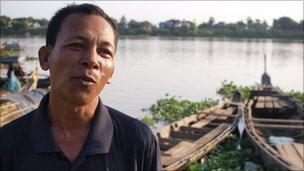The stalled battle for the future of the Mekong River
- Published
The Mekong River is at the heart of many of the countries through which it flows.
Now it is the focus of an epic power struggle, pitching South East Asia's hunger for electricity and development against concerns for the environment, food security and millions of livelihoods.
Damming the mainstream of the lower Mekong would allow countries to generate vast amounts of electricity not only for their own people - but also neighbouring countries.
But the potential downside is enormous - massive changes to the ecosystem across the Mekong basin.
Cashing in
For Laos, the equation is relatively simple. It is one of the world's least developed countries, and hydro power offers it the opportunity to use its abundant natural resources to generate much-needed income.
It has already built dams on tributaries of the Mekong. The largest of them, Nam Theun 2, opened at the end of 2010 and provided a graphic illustration of why Laos is so keen to develop more hydro power projects.
Almost all the electricity generated by Nam Theun 2 goes directly to neighbouring Thailand, via pylons and transmission lines which head up over the hills above the power station whose turbines hum as water released from the recently-created reservoir flows through.

At the fish market in Phnom Penh, fishermen show their catch
That power brings hard cash. Over a 25-year period, the government of Laos is hoping to receive around $2bn (£1.2bn) from Nam Theun 2 alone. And it is keen to promote the benefits that dams can bring.
At the launch of Nam Theun 2, Sivixay Soukkharath, a government worker in charge of resettling villagers affected by the dam, painted a rosy picture.
"The government will give people education, healthcare and infrastructure - and it will allow us to protect the environment throughout the country," he told the BBC.
Rights concerns
Nam Theun 2 was a model project, funded by international donors including the World Bank and Asian Development Bank.
The developers took steps to mitigate the dam's effects on local communities and the environment, creating wildlife reserves and new villages with mains electricity and modern facilities.
Even so, the project attracted criticism from some conservation and human rights groups.
They raised questions about the sustainability of the mitigation efforts and warned of a severe impact downstream.
The prospect of dams on the mainstream of the lower Mekong has roused an even more passionate response.
"It could be a disaster," says Chhith Sam Ath, the executive director of the NGO Forum On Cambodia, an umbrella organisation which represents dozens of community groups concerned about the impact of mainstream hydro power projects.
Laos wants to build the first mainstream dam at Xayaburi, and once again export the electricity to Thailand.
It is keen to portray hydro power as "clean and green", good for the environment as well as the national coffers.
But countries downstream - particularly Cambodia and Vietnam - are far from convinced that their smaller neighbour has studied the possible impact on them.
"Millions of people base their livelihoods on the Mekong," says Chhith Sam Ath.

Chhith Sam Ath from the NGO Forum on Cambodia says the new project could be disastrous
"80% of Cambodian people's protein intake comes from fish. But based on experience from other dams, building a mainstream dam would have a negative impact on fish migration."
At a fishing community on the outskirts of Phnom Penh, people are all too aware of the fragility of their situation.
For them - and millions of other Cambodians - fish provide a source of income as well as protein.
"This river is very important to our community," says Sen Salim, as fellow fishermen untangle their nets at the water's edge.
"When there are many fish it helps us to make a better living. When there are fewer fish it is bad news for us."
Deadlock
These concerns have led to the current stand-off at the Mekong River Commission.
Its four member countries - Vietnam and Thailand as well as Cambodia and Laos - are supposed to agree on all major decisions, and carry out a thorough consultation process before taking action.

Fisherman like Sen Salim rely on the Mekong for their livelihoods
Laos insists that the consultation process is complete and that there is no reason to delay construction of the Xayaburi dam.
But at a special meeting to discuss the project, Laos met strong opposition from its neighbours.
Vietnam called for a 10-year moratorium on mainstream dam projects to allow for studies of possible negative effects.
Cambodia and Thailand both agreed that the existing environmental impact assessment for Xayaburi was inadequate.
With the MRC deadlocked, it is now up to the four countries' governments to resolve the dispute. And the stakes could hardly be higher.
If the Xayaburi project goes ahead, it would open the door to other mainstream Mekong dams. Cambodia has proposed two, and Laos nine.
If they were all built, the Mekong would become a formidable source of power in the region. But it might no longer be the food resource upon which so many people rely.
- Published20 April 2011
- Published10 December 2010